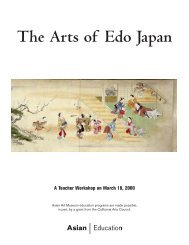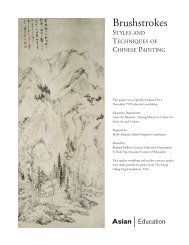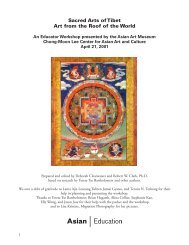China:The Glorious Tang And Song Dynasties - Asian Art Museum ...
China:The Glorious Tang And Song Dynasties - Asian Art Museum ...
China:The Glorious Tang And Song Dynasties - Asian Art Museum ...
Create successful ePaper yourself
Turn your PDF publications into a flip-book with our unique Google optimized e-Paper software.
• Copying works of art was an accepted practice during the <strong>Tang</strong> and <strong>Song</strong> dynasties. It was considered<br />
an important means of learning. Valuable writings were engraved on stone blocks (stele)<br />
and these could be copied again using ink rubbings. <strong>Art</strong>ists also copied earlier paintings; in fact,<br />
we know about many <strong>Tang</strong> artists only through later copies. (One might compare this to our<br />
knowledge of ancient Greek statues through later Roman copies.)<br />
2. DEFINING THE ROLE OF THE ARTIST AND THE DIFFERENT MARKETS THAT THEY SERVED<br />
What can be said about artists during the <strong>Tang</strong> and <strong>Song</strong> dynasties? <strong>The</strong> vast majority of people<br />
who created the works that have survived were anonymous artisans and tradesmen (or in some cases<br />
women). <strong>The</strong>y may have moved around from place to place seeking employment. Some may have<br />
been farmers, who became part-time craftsmen when they were not needed in the fields harvesting<br />
or planting crops. Some were specialized stone carvers or bronze workers. Others specialized in clay,<br />
how to fire kilns, or how to raise silk worms. <strong>The</strong>se workers were responding, just like today’s workers,<br />
to issues of trade, competition, taste and fashion, marketplace dictates, and new ideas from elsewhere.<br />
As we shall see from the many examples of ceramic wares, tastes changed frequently, and<br />
styles fell in and out of favor. Workers had to be inventive; they had to be willing to adjust, to<br />
experiment, and to learn new skills in order to survive.<br />
During the <strong>Tang</strong>-<strong>Song</strong> periods, there was a class of educated artists—initially working at court,<br />
but later working in their own private domains—who began to produce works of art that were<br />
judged more for their aesthetic criteria than their economic or utilitarian value. <strong>The</strong>se scholarartists,<br />
sometimes referred to as literati, or wen-ren (cultured person) developed their own criteria,<br />
their own art criticism, even their own art history. We know very few artists’ names before the <strong>Tang</strong><br />
dynasty, but from the <strong>Tang</strong> and <strong>Song</strong> dynasties onward, we know the names of many, even if only a<br />
few reliable works of art by these artists have survived. We know about these artists names because<br />
the scholar-artists began to write about them, and many of their writings have come down to us.<br />
<strong>Tang</strong>- and <strong>Song</strong>-dynasty calligraphers and painters were educated through a rigorous system of<br />
examinations based largely on knowledge of classic literature, set down by the followers of<br />
Confucius and institutionalized during the Han dynasty. During the <strong>Tang</strong> dynasty, the intervening<br />
Five Kingdoms period, and the <strong>Song</strong>, talented painters became part of official court academies.<br />
<strong>The</strong>se academies had demanding and rigorous standards, and put artists in close proximity to the<br />
emperor himself. <strong>The</strong> painting and calligraphy examples in this packet were produced by scholarartists<br />
working mostly at court. It should be noted that trained artists would have been expected to<br />
be proficient in a number of art forms—painting, calligraphy, poetry, and so on. <strong>The</strong> principal tool<br />
of such artists was brush and ink.<br />
By the <strong>Song</strong> dynasty, some artists began to question the kinds of standards developed at court<br />
academies, rejecting "professional” values in favor of highly personal or “amateur” values. (This<br />
dichotomy became a defining theme for painting in the following period, the Yuan dynasty.) In a<br />
parallel development, the <strong>Tang</strong> and <strong>Song</strong> witnessed the rise of calligraphy as a high art form,<br />
through the adoption of past masters as models of orthodox style; some more progressive and idiosyncratic<br />
calligraphers began to reject these official styles championing instead very personal forms<br />
of calligraphic expression. <strong>The</strong> proliferation of new styles of painting and calligraphy—whether<br />
47
















